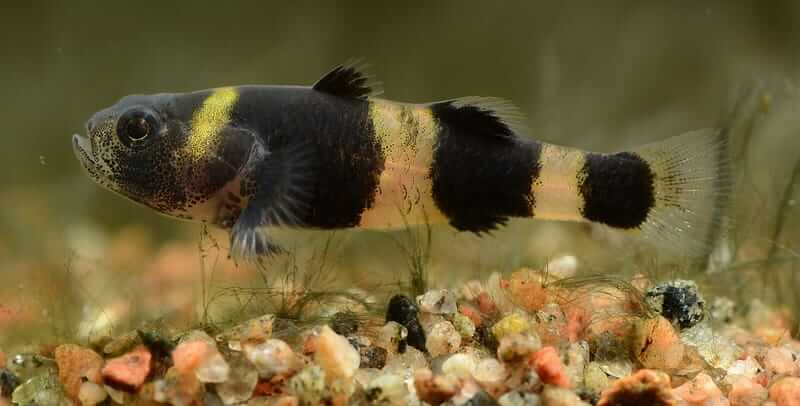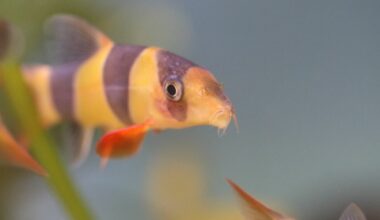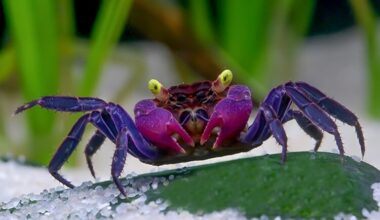The bumblebee goby is hands-down one of our favorite fish. These interesting and adorable little critters steal the show in almost any aquarium, and we’ve heard from countless owners who can’t stop talking about them.
But there are some aspects of bumblebee goby care that you’ll need to be comfortable with if you plan on getting one for yourself. These are fish that need brackish water and have specific diet requirements in order to thrive.
Fortunately, once you know what to do caring for this fish becomes much easier. Read on to learn everything you need to know!
Table of Contents
Species Summary
The bumblebee goby is certainly a unique specimen to care for. Thanks to their eye-catching looks, these fish have become quite popular among aquarists.
Scientifically, bumblebee gobies are known as Brachygobius. Technically speaking, Brachygobius is the genus name. There are several types of fish sold under the “Brachygobius” moniker, but the differences are so minor that most can’t even tell them apart.
The bumblebee goby originated in Southeast Asia. They’re usually found in slow-moving streams and tributaries around Indonesia, Vietnam, and Thailand.
While this fish species is highly sought-after in the fish community, they aren’t the easiest to care for. Bumblebee gobies require a carefully planned habitat and a high-quality diet to thrive. If you’re looking for a piece of cake species that doesn’t require any effort, this isn’t the fish for you.
Lifespan
The average bumblebee goby lifespan is around three years under normal conditions. This is mostly due to the specific care requirements this species needs in captivity.
However, these fish are capable of living a bit longer. Some aquarists have seen their gobies live to be four years or older!
This is only possible by providing incredibly consistent high-quality care (with an added benefit of good genetics). Not only do owners need to work hard to maintain water conditions at all times, but they must also provide them with a comfortable and stress-free life.
Appearance
The given trade name of these fish does a pretty good job of describing their physical appearance. The first thing you’ll notice is their distinct striped pattern. Alternating stripes of black and yellow cover their entire bodies.

The exact hue of the yellow stripes can vary a bit from fish to fish. Some specimens can have pale yellow patterns while others lean more on the side of orange. Typically, it’s the male fish who are the most vibrant.
When it comes to shape, bumblebee gobies have that iconic “goby” shape. They have small heads and relatively slender bodies. Males tend to be a bit slimmer than females. However, both have the same round head and bulbous eyes.
For the most part, the fins are transparent. On some fish, the fins have a little black in them, too. Usually, it’s an extension of the corresponding stripe.
Size
These fish aren’t very big at all. At full maturity, the average bumblebee goby size is only about an inch and a half long! Some don’t even make it to that.
Because they’re so small, this species is a great choice for anyone looking for an interesting nano fish. Although if you’re going to try and maximize their lifespan you’ll probably want a slightly bigger setup than that.
Bumblebee Goby Care
As we mentioned earlier, bumblebee gobies care can be a little tricky. This species does require a bit more work than a simple Goldfish or some other straightforward species.
With that said, caring for this quirky fish is manageable. The key is to have a strong understanding of their specific needs and provide them with optimal living conditions.
Tank Size
One of the easiest things you can manage is tank size. Bumblebee gobies do just fine in a standard 10-gallon tank. Thanks to their small size, you can keep several fish in a single 10-gallon nano tank without any issues.
As long as the tank isn’t overcrowded, the fish can stay happy and healthy in close quarters.
Author Note: An anecdotal observation we’ve made over the years is that bumblebee gobies seem to live a little bit longer when placed in larger tanks. If you’re trying to maximize their lifespan and surpass the three-year mark this is something to consider.
Water Parameters
Here’s where things start to get a bit tricky. Bumblebee gobies are naturally found in slightly brackish ponds. Some fish will require low salinity levels in their tank to stay healthy. Others can do fine in pure freshwater.
When you’re purchasing bumblebee gobies, it’s important to get more information about how they were raised. While many breeders stick to a brackish water setup, there are some out there who have managed to raise and breed the fish without any salt whatsoever.
You need to match your tank with the water quality the fish were raised in. Otherwise, it’s very likely that you’ll shock their system which will eventually lead to death.
Beyond salinity levels, bumblebee gobies are relatively hardy. They like slightly alkaline water and warm temperatures. Here are the parameters to keep an eye on:
- Water temperature: 72 to 84 degrees Fahrenheit (73.5 to 79 degrees is ideal)
- pH levels: 7.0 to 8.5
- Water hardness: 9 to 19 dKH
- Water salinity: 1.002 to 1.006 salt grade
What To Put In Their Tank
Like any fish, it’s best to mimic their natural environment. In the ponds and streams bumblebee gobies are found in, they enjoy tons of hiding spaces.
Start out with a nice sandy substrate. These are bottom-feeder fish that tend to spend their time near the substrate. Some bumblebee gobies even like to dig into the sand a bit. A thick and chunky substrate, such as gravel, would make that difficult and pose a bit of a risk for injury.
Next, provide plenty of natural decorations. These critters can be a bit skittish at first. This is especially true if they share a tank with other fish. Providing hiding spots can help them feel safe and calm.
Use plants, rocks, and driftwood throughout. Items like coconut hides or even ceramic tubes are much-appreciated, too.
Once you have everything planned out accordingly, you need to set up the filtration system. Tanks should be fully cycled before you add the fish. This will give you the opportunity to make fine adjustments to the water quality.
A standard sponge filter that you hang inside or outside the tank will do. The main thing you need to worry about is how the tank affects water flow.
Author Note: Bumblebee gobies don’t tolerate strong water flow too well. So, strong water pumps or even air bladders won’t do. Keep things simple. The flow from a standard filter should be enough to keep the water moving without making things difficult for the fish.
Diseases To Look Out For
Diseases can be pretty common with the bumblebee goby. However, this is usually caused by factors owners control.
Typically, diseases are caused by stress and poor water conditions. Unfortunately, many fish of this species come down with Ich and other stress-related diseases because the salinity levels aren’t right.
Fish who were raised in brackish water must have some salt. Moving them to a completely freshwater tank sends the body into shock, which results in the aforementioned disease.
We can’t stress enough how important water quality is for bumblebee gobies. Be vigilant about keeping their tank conditions at optimal levels. Reach out to your fish supplier beforehand and mimic their water conditions exactly.
While they do exist, freshwater bumblebee gobies are rare. You need to make sure that you’re purchasing from a reputable freshwater breeder if you don’t want to deal with brackish water. Make sure that the fish has spent their entire life in freshwater before you commit.
After you’ve introduced your fish to their new home, whether it’s brackish or not, keep monitoring the water (make sure to use a good test kit). Perform water changes regularly and don’t forget to test salinity levels if you didn’t purchase from a specialty freshwater breeder.
Usually, you can achieve the desired salinity levels with nothing more than a teaspoon of salt per gallon. Of course, exact measurements are always best, so test regularly.
If your fish does come down with Ich, it’s important to quarantine them as soon as possible. The disease is very contagious and has been known to wipe out entire tanks. You can use over-the-counter copper-based medicines to treat the affected fish once it’s quarantined.
Author Note: Don’t underestimate the power of regular visual inspections. Spend a couple of minutes each day making sure that nothing looks out of place and your fish aren’t showing any concerning symptoms. This simple habit can make a big difference.
Food & Diet
Here’s another tricky part about owning bumblebee gobies. They can be picky eaters!
Most will not even take a bite of dry food. They’re carnivores that rely on a protein-rich diet. This means you’ll have to invest in quality live or frozen food to keep your fish healthy.

Bloodworms, daphnia, and tubifex worms are great options. Many aquarists also provide brine shrimp, as they are easy to hatch and cultivate.
This is one of the aspects of bumblebee goby care that discourages a lot of potential owners. Fortunately, once you get a system figured out for feeding time it won’t seem like such a big deal!
Behavior & Temperament
Generally speaking, bumblebee gobies are quite peaceful. They’re passive creatures that would rather hide than show aggression.
With that said, some territorial behavior has been observed. The fish will usually claim a small part of the tank as their own and guard it heavily. If another fish of the same species enters, they may spar a bit. However, this is usually just light fighting and never results in serious injury.
Bumblebee gobies do like to socialize with their own kind. They do exceptionally well when they’re kept with other bumblebee fish. They’ll group up and swim around for a while until they’re ready to go their separate ways.
Bumblebee Goby Tank Mates
Finding adequate tank mates for the bumblebee goby isn’t always easy. This is due, in large part, to their brackish water needs. Their temperament is never the issue!
Furthermore, the small size of the fish can make them a target for larger species. Other fish will be competing for the food you provide. Thanks to their small stature, they’ll almost always lose those battles.
For these reasons, many aquarists keep bumblebee gobies in a single-species tank. You can create a small community of several other bumblebee gobies. We recommend a group of around 7 fish for a 10 or 15-gallon tank.
You can also add some shrimp to the mix. Stick with large shrimp to ensure that the fish don’t see them as food. This means species like cherry shrimp aren’t a great idea.
So, in summary you’re looking at other bumblebee gobies or larger shrimp as viable tank mates. In our opinion considering other options isn’t a good idea.
Breeding
Bumblebee gobies are egg-layers. Females can lay upwards of 200 eggs at one time!
Triggering the breeding process isn’t too difficult. Typically, breeders will simply provide food with higher protein content than normal. Some will also add a bit of freshwater to the tank.
You’ll know that the fish are breeding when you see females start to swell up. She’ll lay her eggs in small hiding spots. If you’re planning ahead, add some smooth ceramic tubes or an overturned dome to the tank. That’ll be the perfect place to keep the eggs safe.
Once the eggs are laid, remove them from the tank. Alternatively, you can move all of the adult fish to another tank. Whichever option you choose, leave the father behind.
Males will guard the eggs fiercely. After about a week, the eggs will hatch! At this point, you can separate the male so that he doesn’t eat any of the fry.
In another week, the fry should be able to swim freely. Feed them infusoria cultures until they’re large enough to eat baby brine shrimp.
It’s Time To Make A Decision
Tons of people are drawn to the bumblebee goby because of their unique and cute appearance. They envision having a ton of these little fishes swimming around their tank while they sit back and enjoy.
But when they find out about some of the care requirements they lose interest.
Before considering getting this fish you should consider if you’re willing to provide them with proper care. Brackish waters and a live diet can increase the amount of time you spend on your aquarium rather significantly.
If you’re someone who just wants a low-maintenance and easygoing fish, then there are plenty of other cute fish to consider.
However, if this doesn’t deter you then we encourage you to give it a shot. In our experience, the fish that require a little extra attention end up being the most rewarding.
We’ve had great experiences with these fish and know many other owners who feel the same way. We just want to make sure you have a realistic expectation of what owning these fish is like!
Bumblebee goby care is a unique experience, and if you’re up for the challenge we know you’ll have a great time.

